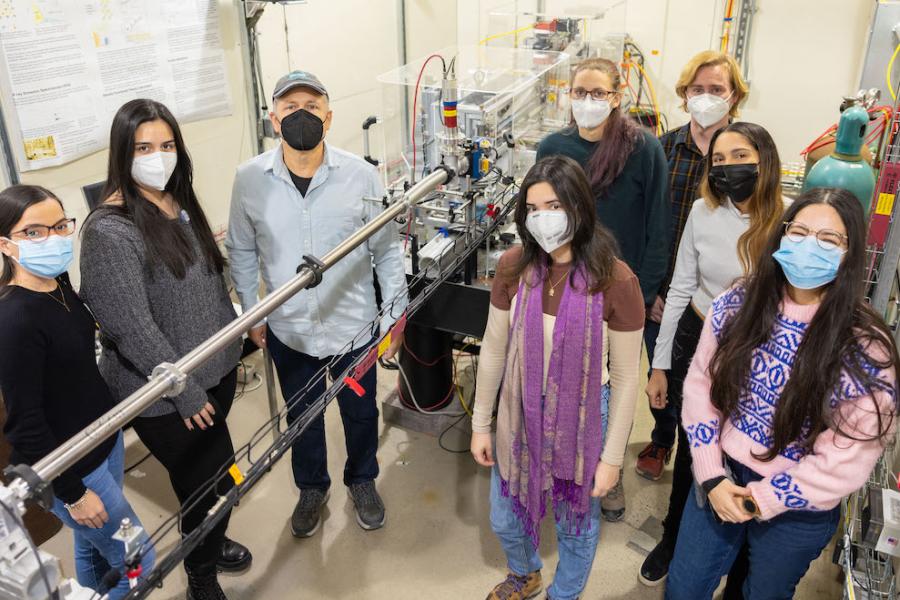In his dark basement lab in Wurzberg Germany in 1895, Wilhelm Röntgen produced the first-ever X-ray image using a cathode ray tube – a radiograph of his wife’s hand, wedding ring and all. Today, 60 feet below the Cornell University campus, at the Cornell High Energy Synchrotron Source (CHESS), researchers utilize X-rays that are 100 million times more intense than Röntgen's first beams of light.
Researchers at CHESS examine proteins that reveal new ways to fight cancer, battery cells that enable a charge far beyond current capabilities, and structural materials that enable space travel to improve with lightweight, yet more structurally sound components. Today’s high energy X-rays provide scientific advances and innovation far beyond what Röntgen could have ever imagined.
The story of how we went from low-powered X-rays to the powerful technology now used at CHESS and other light sources around the world pivots on the first observation of synchrotron radiation 75 years ago, on April 24th, 1947 at General Electric in Schenectady, NY.
Shortly after this initial discovery, researchers at Cornell characterized and verified synchrotron radiation with a 300MeV synchrotron in the basement of Newman laboratory on the Ithaca campus.
For many years, however, the radiation produced by synchrotrons was seen as a nuisance. It was seen as a “hazard” that researchers had to shield against, and the radiation also meant losses in the energy of the synchrotron beam that had to be “topped off” constantly in order to keep the beams consistent. Furthermore, the X-rays weren’t deemed particularly useful at this time, as researchers could much more easily (and cheaply) produce X-rays in their own labs by using the widely-available rotating anode tubes.
Nevertheless, synchrotron research at Cornell has persisted and flourished for decades, also playing an integral role in advancing the utility of synchrotron radiation. Several synchrotrons were built in quick succession following the 300MeV machine – first at 1.4 GeV, then 2.2 GeV, and 10 GeV (eventually extended to 12 GeV). Construction of the 10 GeV synchrotron at Wilson Lab was completed in 1968 and is still currently operated today on Cornell’s campus.
This synchrotron and its predecessors were all created exclusively for the field of high energy physics – particle collision experiments. In 1974 however, a handful of researchers like Val Kostroun, a Research Associate at Wilson Lab, were granted research time to use the X-rays produced by the synchrotron. Kostroun and his colleagues made up the SYnchrotron RAdiation (SYRA) group at Cornell – the first group to specifically study synchrotron radiation at Cornell.
High energy physics continued to dominate the show at Wilson Lab with the advent of the Cornell Electron Storage Ring, CESR. The storage ring was constructed to power electron-positron collisions inside CLEO, its sister particle detector, which was commissioned along with CESR in 1979.
As CESR and CLEO were being built, it was decided that Wilson Lab could also provide a modest synchrotron radiation facility, and the Cornell High Energy Synchrotron Source (CHESS) was started in 1978.
Boris Batterman, the first CHESS director (1978-1997), fought to secure NSF funding for three X-ray beamlines that would run parasitically to CESR, making use of the radiation it produced. CHESS continued to operate in this manner until CLEO was decommissioned in 2008, which turned CESR’s primary purpose from high energy physics studies to synchrotron radiation production for CHESS.
Prior to decommissioning CLEO, CHESS was one of the only synchrotrons doing particle collisions and X-ray experiments at the same time.
CHESS's impact
75 years after the first discovery of synchrotron light at GE, as CHESS enters its 43rd year of operations, the scientific advancements and discoveries at CHESS have grown continuously, thanks to its inherent connection to Cornell University, and particularly the Cornell Laboratory for Accelerator-based ScienceS and Education, CLASSE.
The second Nobel Prize awarded for research using synchrotron radiation was awarded for work done at CHESS. Roderick MacKinnon and Peter Agre were awarded the Nobel prize in chemistry for their mapping of potassium ion channels, a fundamental process in the transportation of charged atoms in living organisms, using X-ray crystallography primarily performed at CHESS and the National Synchrotron Light Source.
The fact that this research was conducted at CHESS is part of the story of what makes CHESS unique. As Sol Gruner, CHESS Director from 1997-2013 tells it, the flexibility of the facility is what allowed the research to happen at CHESS:
“With CHESS being on Cornell’s Campus,” says Gruner, “that means that the philosophy that people use when they try to do experiments here is really quite different than in the government laboratories. At CHESS, for a much longer period of time, the beamlines weren’t dedicated. So, people try out crazy experiments, and CHESS did a lot of crazy experiments! That's one thing I find attractive about it.”
CHESS’s contributions to the world of synchrotron radiation are not just borne from the results of the research conducted in the facility, but also by the technical advancements at the facility itself.
The undulator is among the most important components of an X-ray beamline, and traditionally a major driver of beamline cost. Cornell scientists developed the Cornell Compact Undulator (CCU), which is about a meter and a half long, less expensive than traditional undulators, and light enough to be moved by two people. The compact undulator also allowed for the CHESS-U upgrade, completed in 2019.
CHESS-U allowed for operation of a single positron beam, instead of counter-rotating electron and positron beams. This eliminated many of the performance limitations associated with two-beam operation and enabled all beamlines to be aligned to a single orbit, allowing for future expansion of the synchrotron facility.
CHESS has also been a hotbed for the development of X-ray detector technology, an area where CHESS greatly benefits by being connected to a large research university. There is an ever-growing pool of affiliated scientists and engineers on the Cornell campus who research and develop X-ray detector technology, and have done so over the years in close collaboration with CHESS scientists and using the testing ground provided by CHESS.
Accelerating into the future
CHESS continues to build on its legacy of innovation, education, and discovery today. Ground was recently broken on a new experimental hall which will expand the synchrotron radiation facility. The new hall will contain one planned beamline and the potential for three additional beamlines in the future. The planned beamline, the High Magnetic Field (HMF) beamline, is a collaboration with the National Magnetic Field Lab and the University of Puerto Rico.
X-rays can uniquely address fundamental, long-standing questions about the nature of matter in high magnetic fields, and the new HMF facility will enable research that is currently not achievable anywhere else in the world.
The HMF project will not only create new opportunities for research, it will help to train the next generation of high energy X-ray scientists and technicians as well.
“This new beamline will be a generational change for both CHESS and the X-ray community,” said Joel Brock, director of CHESS. “While we have plenty of X-ray users at CHESS, the pipeline for beamline scientists – the people that know how to build an actual beamline – is drying up. This new project will not just expand the lab, it will also expand the network of experts of the underpinnings of the technology. That is why the education of undergraduates, grad students and postdocs is a major part of this project.”
This is the natural evolution of Cornell’s legacy in advancing synchrotron and X-ray research. As one of the only synchrotron lightsource facilities in the world located on a university campus, CHESS plays a unique role.
“That means that you have students involved in a way that they’re not involved in other places, typically” explains Gruner. “What that really means to me is that the special role that CHESS has traditionally played is special. That role is to develop new technologies, new techniques, and new ways of doing things.”
“For over forty years, CHESS has had this amazing track record of developing new X-ray technology and techniques, of scientific discovery, of the highest levels of user support, and of training the leaders of the synchrotron field,” says Joel Brock, Director of CHESS. “The CHESS-U upgrade to CESR and the CHESS experimental floor, the addition of new funding partners, and the new experimental hall to house the High Magnetic Field facility have positioned CHESS to continue to be a world-leading high-energy synchrotron facility for the foreseeable future.”





